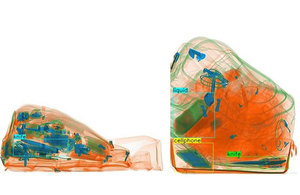Dozens of new “high-tech” bag scanners are being rolled out across 44 prisons in the UK as part of plans to crack down on drugs and phones behind bars.
Deputy prime minister Dominic Raab announced that more than 80 “cutting edge” X-ray machines will be installed by the end of March.
These machines will join existing body scanners, drug-trace machines, and metal detection archways, which the government says have stopped tens of thousands of items from "wreaking havoc inside prisons”.
The Ministry of Justice said that these machines have already stopped a huge amount of illegal contraband from getting into prisons, including: 99 sheets of ‘spice’ paper—worth almost £60,000; nearly £40,000 worth of cannabis and tobacco concealed in curry and beef stew tins; and a bottle of washing-up liquid that tested positive for heroin.
The government department said that the "most challenging” prisons will be the first to use the machines, which include “high-quality” sharp images to detect drugs, phones, and high-density materials.
“These X-ray bag scanners are a powerful addition to the body scanners, drug-trace machines, metal detection archways and extra drug dogs we have added in recent years to keep drugs, mobile phones and other contraband out of our prisons,” said deputy prime minister and justice secretary, Dominic Raab. “This is getting more prisoners off drugs, and helping to keep our streets safer.”
The move comes after the introduction of 75 X-ray body scanners across 74 male prisons, which the government says have disrupted around 20,000 attempts to smuggle drugs and other harmful items into prisons in two years.
In 2022, dozens of prisons also introduced new drug-trace machines that can detect microscopic smears of new psychoactive substances such as ‘spice’ on mail and items of clothing.
Latest News
-
PornHub probes reported breach affecting premium users’ viewing data
-
Apple’s iPhone to support alternative app stores in Japan
-
Google partners with Indian bank to roll out credit card
-
Barclays to trial AI-driven platform to drive SME sustainability insights
-
Former UK chancellor George Osborne to join OpenAI
-
Amazon ‘in talks to pour $10bn’ into OpenAI
The future-ready CFO: Driving strategic growth and innovation
This National Technology News webinar sponsored by Sage will explore how CFOs can leverage their unique blend of financial acumen, technological savvy, and strategic mindset to foster cross-functional collaboration and shape overall company direction. Attendees will gain insights into breaking down operational silos, aligning goals across departments like IT, operations, HR, and marketing, and utilising technology to enable real-time data sharing and visibility.
The corporate roadmap to payment excellence: Keeping pace with emerging trends to maximise growth opportunities
In today's rapidly evolving finance and accounting landscape, one of the biggest challenges organisations face is attracting and retaining top talent. As automation and AI revolutionise the profession, finance teams require new skillsets centred on analysis, collaboration, and strategic thinking to drive sustainable competitive advantage.
© 2019 Perspective Publishing Privacy & Cookies


.jpeg)








Recent Stories